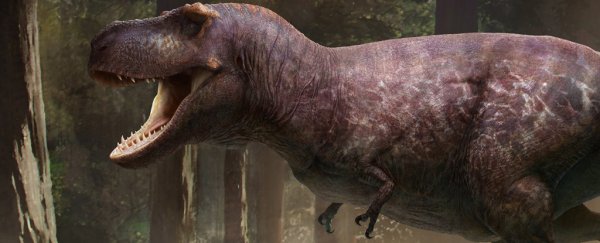The teeny tiny arms of Tyrannosaurus rex have been the butt of jokes for many scientists and non-scientists alike. We have various hypotheses: perhaps its arms were vicious slashing machines or a way to help grasp on during sex, but it's hard to work out these sorts of evolutionary questions from a pile of 66 million-year-old bones.
A new paper now presents a wild hypothesis – that these dinosaurs evolved short arms to lower the risk of accidental bites by other T. rex while engaging in feeding frenzies. Put simply, short arms are less likely to be chomped on by friends.
"What if several adult tyrannosaurs converged on a carcass? You have a bunch of massive skulls, with incredibly powerful jaws and teeth, ripping and chomping down flesh and bone right next to you. What if your friend there thinks you're getting a little too close? They might warn you away by severing your arm," says Kevin Padian, integrative biologist at the University of California, Berkeley and the author of the new paper.
"So, it could be a benefit to reduce the forelimbs, since you're not using them in predation anyway."
Paleontologists are getting ever better at understanding what dinosaurs looked like, thanks to fossil finds of skin and feathers (or buttholes), and we can make some assumptions on what dinosaurs did because of how the bones are placed, or footprints that provide more information about their habits.
But complex evolutionary questions are still difficult to determine even for species whose behaviors we can watch, or have access to the genomes of their ancestors. Get to an ancient animal like T. rex, and it's all the more frustrating to figure stuff out.
While T. rex arms look laughably small, proportionally speaking they're even more ludicrous when compared to other animals. Let's imagine a 14-meter (45 feet) long T. rex. They might have a 1.5-meter-long skull, but their arms would only be a meter long. This is the equivalent of a 6-foot human with 12-centimeter (5 inch) arms.
To try and work out if this new 'friend arm biting' hypothesis had any legs (ha ha), Padian took measurements of a mostly complete fossil specimen called MOR 555. Using these measurements, he suggests that some of the previous hypotheses – including both the sexual aid and slashing arms hypothesis – are unlikely, as T. rex arms are just too small and weak to be of use.
He instead posits it could have been evolutionarily advantageous to have tiny arms, to get them out of the way for group feeding.
"Longer arms, especially in their natural, somewhat anteriorly extended orientation, would have brought them into the ambit of the deadliest jaws ever recorded on land. The danger of wounds, amputations, infections, disease and ultimate death .. would have been a selective force for reduction, irrespective of relict functionality of the limbs," explains Padian in his paper.
"Let us hypothesize, therefore, that the reduction of forelimb size was a secondary function of selection for something else. As such, we should not look for functionality in these reduced limbs, but for how that reduction served a larger purpose."
Of course, like the other suggestions above, this is a hypothesis. In the paper Padian suggests some ways that other researchers might be able to test it: for example, if we found relatively fewer bite marks on their arm bones than other parts of their bodies.
"What I first wanted to do was to establish that the prevailing functional ideas simply don't work," he said.
"That gets us back to square one. Then, we can take an integrative approach, thinking about social organization, feeding behavior and ecological factors apart from purely mechanical considerations."
The research has been published in Acta Palaeontologica Polonica.
